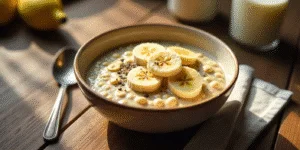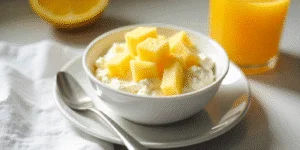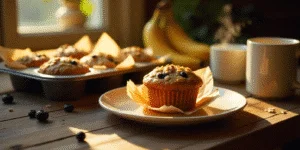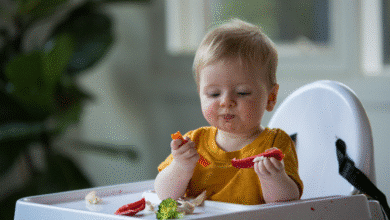10 healthy breakfast ideas for 5 year olds
Eating a healthy breakfast is very important for adults, but when it comes to children, especially 5-year-olds, the benefits are even greater. That’s why exploring healthy breakfast ideas for 5 year olds can make a big difference in their growth, energy, and focus throughout the day.
Children at the age of 5 need strong nutritional support to get the essential nutrients their bodies require. At this stage, their physical development is still in the early phases, and they don’t yet have a strong foundation. That’s why they must receive all the necessary vitamins and minerals through healthy breakfast meals specifically designed for healthy breakfast ideas for 5 year olds
That’s why we’ve decided to gather healthy breakfast ideas for 5 year olds , to give you a variety of simple and inspiring options to start with. These meals are carefully selected to provide a rich source of essential nutrients that support your child’s healthy growth and development.
Why Breakfast Matters for 5-Year-Olds

We can highlight some of the key benefits that children at this age can gain from having a healthy breakfast ideas for 5 year olds
At this age, children tend to be active and constantly on the move which makes it important to channel that energy into better focus and learning. A healthy breakfast at this stage acts as fuel, helping to boost their concentration and energy levels throughout the day.
If the breakfast a child gets at this age includes the essential nutrients they need such as protein, carbs, healthy fats, vitamins, zinc, iron, and calcium it will effectively support their healthy growth and development.
10 Healthy Breakfast Ideas for 5-Year-Olds
Here’s a collection of healthy breakfast ideas for 5-year-olds that are perfectly suited to support their growth, energy, and nutritional needs.
Scrambled eggs with cheese and toast
Basic Ingredients
- 2 medium-sized eggs,
- 30 grams of cheddar or mozzarella cheese (optional, based on taste)
- 2 slices of toasted bread (preferably whole wheat)
- 1 teaspoon of butter or olive oil (for cooking)
- A pinch of salt and pepper to taste
Approximate Nutritional Value of the Meal:
-
Calories: Approximately 350–400 kcal
-
Carbohydrates: Around 25–30 grams (primarily from bread)
-
Protein: About 20–25 grams (mainly from eggs and cheese)
-
Fat Approximately 20 grams (sourced from cheese, eggs, and butter)
Mini pancakes with almond butter
Basic Ingredients
-
Pancake mix (you can use a store-bought mix or make homemade pancakes using whole wheat flour, eggs, and milk)
-
2 teaspoons of almond butter,
-
1 teaspoon of honey or maple syrup (optional for sweetness)
-
Fresh fruits for serving (such as banana slices or berries)
Approximate Nutritional Value of the Meal:
-
Calories: Around 300–350 kcal
-
Carbohydrates: Approximately 35–40 grams (mainly from the pancakes and fruits)
-
Protein: Around 7–9 grams (from the eggs, whole wheat flour, and almond butter)
-
Fats: About 12–15 grams (mostly healthy fats from almond butter)
Oatmeal with banana & chia seeds

Basic Ingredients
-
½ cup of oats (cooked or soaked)
-
1 medium banana (sliced)
-
1 tablespoon of chia seeds
-
1 cup of milk (can be dairy or plant-based, such as almond milk)
-
1 teaspoon of honey or maple syrup (optional for sweetness)
Approximate Nutritional Value:
-
Calories: Around 300–350 kcal
-
Carbohydrates: Approximately 50 grams (mainly from oats and banana)
-
Protein: About 6–8 grams
-
Fat: Around 7–9 grams (mostly from chia seeds)
-
Fiber: 8–10 grams (supports healthy digestion)
Greek yogurt with berries and granola
Basic Ingredients
-
1 cup plain Greek yogurt (unsweetened)
-
½ cup mixed berries (blueberries, raspberries, strawberries)
-
¼ cup healthy granola (preferably low-sugar variety)
-
1 teaspoon honey (optional for sweetness)
Approximate Nutritional Value per Serving:
-
Calories: Around 300–350 kcal
-
Carbohydrates: Approximately 30–35g (mainly from berries and granola)
-
Protein: About 15–20g (from Greek yogurt)
-
Fat: Roughly 5–7g (depending on the granola used)
-
Fiber: Around 5g
Cottage cheese with pineapple chunks

Basic Ingredients
-
½ cup of cottage cheese
-
½ cup of fresh or unsweetened canned pineapple chunks
-
1 teaspoon of honey (optional, for sweetness)
-
A pinch of cinnamon or mint (optional, for added flavor)
Approximate Nutritional Value of the Meal:
-
Calories: Around 150–200 kcal
-
Carbohydrates: About 15–20 grams (mostly from pineapple)
-
Protein: Approximately 12–15 grams (from cottage cheese)
-
Fat: Around 2–4 grams (depending on the cheese used)
-
Fiber: About 1–2 grams (from pineapple)
Whole grain waffles with strawberries
Basic Ingredients
-
2 pieces of whole grain waffles
-
½ cup fresh strawberries (sliced)
-
1 teaspoon honey or maple syrup (optional for sweetness)
-
1 tablespoon Greek yogurt or almond butter (optional for added protein and healthy fats)
Approximate Nutritional Value of the Meal:
-
Calories: Approximately 300–350 kcal
-
Carbohydrates: Around 45–50 grams (mostly from whole grains and strawberries)
-
Protein: Approximately 8–10 grams
-
Fat: Around 5–7 grams (depending on additions such as yogurt or almond butter)
-
Fiber: Approximately 6–8 grams
Avocado toast with boiled egg slices
Basic Ingredients
-
2 slices of toast (preferably whole grain)
-
½ ripe avocado, mashed
-
1 or 2 boiled eggs, sliced
-
A pinch of salt and black pepper to taste
-
A few drops of lemon juice (optional, for added flavor and to prevent avocado from browning)
Approximate Nutritional Value of the Meal:
-
Calories: Around 350–400 kcal
-
Carbohydrates: Approximately 30–35 grams (mainly from toast and avocado)
-
Protein: About 12–15 grams (mostly from eggs)
-
Fat: Around 20 grams (healthy fats from avocado and eggs)
-
Fiber: Approximately 7–8 grams
Baked oatmeal muffins

Basic Ingredients
-
1 cup of ground or whole oats,
-
1/2 cup of milk (dairy or plant-based)
-
1 egg,
-
1/4 cup of honey or natural sugar (optional)
-
1/2 cup of fruit such as berries or mashed bananas,
-
1/4 cup of chopped nuts (e.g., walnuts or almonds)
-
1 teaspoon of baking powder
-
A pinch of salt and cinnamon (optional)
Approximate Nutritional Value
-
Calories: Around 150–180 kcal
-
Carbohydrates: Approximately 25 grams
-
Protein: Around 4–5 grams
-
Fat: Around 4–6 grams
-
Fiber: Approximately 3–4 grams
Apple slices with peanut butter
Basic Ingredients
-
1 medium-sized apple, sliced,
-
2 tablespoons of natural peanut butter (no added sugar)
Approximate Nutritional Value
-
Calories: Around 200–250 kcal
-
Carbohydrates: Approximately 25–30 g (mostly from the apple)
-
Protein: About 6–8 g (from peanut butter)
-
Fat: Around 15–18 g (mostly healthy fats)
-
Fiber: Approximately 4–5 g (from the apple)
read more : Best country breakfast casserole with hash browns
Frozen Waffles or Pancakes
Basic Ingredients
-
Frozen waffle or pancake (depending on preference)
-
Optional toppings: Sliced fruits, honey, butter, yogurt, or maple syrup
Approximate nutritional value per piece
-
Calories: Around 150–200 kcal
-
Carbohydrates: Around 25–30 grams
-
Protein: Around 3–5 grams
-
Fat: Around 3–6 grams
-
Fiber: Around 1–2 grams
Unusual or fun shapes always spark children’s curiosity, making them eager to explore and interact with them and the same applies to food and their meals. If you apply this concept to breakfast, you’ll likely boost your child’s interest in eating their meal.
Use colorful plates and forks
You can make your child more attracted to food by tapping into their natural curiosity. Children are drawn to unusual items and colors they may not have seen before and all of this increases their desire to try or explore the food.
read more : Tasty Vegan Meals for Picky Eaters Creative Ideas
Breakfast Mistakes Pediatricians Warn About
Too much added sugar
Try to make sure your 5-year-old child’s meal does not contain a large amount of sugar. It is not recommended for children to consume excessive amounts of sweets or sugar at this age.
Relying on sugary cereals
Also, sweetened cereals that contain high amounts of sugar can harm your child they may negatively affect their teeth and overall health.
Artificial juices instead of whole fruit
Relying on artificial juices won’t provide your child with any real health benefits at this young age. However, natural juices can offer this advantage, as they contain the essential vitamins and nutrients your child needs.
FQA
How to get a 5 year old to eat breakfast
Offer him fun and appealing meals to encourage him to eat, and you can also start with light meals at first so he can gradually get used to it until it becomes a healthy habit for him.
What time should a 5 year old eat breakfast
It is usually recommended that breakfast be eaten within two hours of waking up, as it greatly helps in energizing the body, stimulating the mind, and boosting overall energy levels.
Can 5-year-olds eat eggs every day?
At this age, a child needs a high amount of protein and calcium, but relying on just one nutrient may not encourage the child to consistently eat breakfast.




